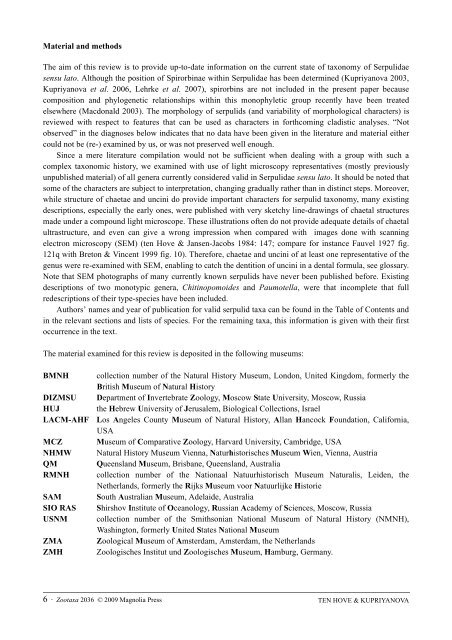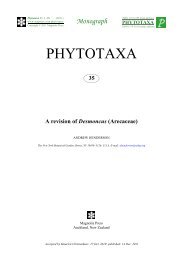Zootaxa, Taxonomy of Serpulidae (Annelida ... - Magnolia Press
Zootaxa, Taxonomy of Serpulidae (Annelida ... - Magnolia Press
Zootaxa, Taxonomy of Serpulidae (Annelida ... - Magnolia Press
You also want an ePaper? Increase the reach of your titles
YUMPU automatically turns print PDFs into web optimized ePapers that Google loves.
Material and methods<br />
The aim <strong>of</strong> this review is to provide up-to-date information on the current state <strong>of</strong> taxonomy <strong>of</strong> <strong>Serpulidae</strong><br />
sensu lato. Although the position <strong>of</strong> Spirorbinae within <strong>Serpulidae</strong> has been determined (Kupriyanova 2003,<br />
Kupriyanova et al. 2006, Lehrke et al. 2007), spirorbins are not included in the present paper because<br />
composition and phylogenetic relationships within this monophyletic group recently have been treated<br />
elsewhere (Macdonald 2003). The morphology <strong>of</strong> serpulids (and variability <strong>of</strong> morphological characters) is<br />
reviewed with respect to features that can be used as characters in forthcoming cladistic analyses. “Not<br />
observed” in the diagnoses below indicates that no data have been given in the literature and material either<br />
could not be (re-) examined by us, or was not preserved well enough.<br />
Since a mere literature compilation would not be sufficient when dealing with a group with such a<br />
complex taxonomic history, we examined with use <strong>of</strong> light microscopy representatives (mostly previously<br />
unpublished material) <strong>of</strong> all genera currently considered valid in <strong>Serpulidae</strong> sensu lato. It should be noted that<br />
some <strong>of</strong> the characters are subject to interpretation, changing gradually rather than in distinct steps. Moreover,<br />
while structure <strong>of</strong> chaetae and uncini do provide important characters for serpulid taxonomy, many existing<br />
descriptions, especially the early ones, were published with very sketchy line-drawings <strong>of</strong> chaetal structures<br />
made under a compound light microscope. These illustrations <strong>of</strong>ten do not provide adequate details <strong>of</strong> chaetal<br />
ultrastructure, and even can give a wrong impression when compared with images done with scanning<br />
electron microscopy (SEM) (ten Hove & Jansen-Jacobs 1984: 147; compare for instance Fauvel 1927 fig.<br />
121q with Breton & Vincent 1999 fig. 10). Therefore, chaetae and uncini <strong>of</strong> at least one representative <strong>of</strong> the<br />
genus were re-examined with SEM, enabling to catch the dentition <strong>of</strong> uncini in a dental formula, see glossary.<br />
Note that SEM photographs <strong>of</strong> many currently known serpulids have never been published before. Existing<br />
descriptions <strong>of</strong> two monotypic genera, Chitinopomoides and Paumotella, were that incomplete that full<br />
redescriptions <strong>of</strong> their type-species have been included.<br />
Authors’ names and year <strong>of</strong> publication for valid serpulid taxa can be found in the Table <strong>of</strong> Contents and<br />
in the relevant sections and lists <strong>of</strong> species. For the remaining taxa, this information is given with their first<br />
occurrence in the text.<br />
The material examined for this review is deposited in the following museums:<br />
BMNH collection number <strong>of</strong> the Natural History Museum, London, United Kingdom, formerly the<br />
British Museum <strong>of</strong> Natural History<br />
DIZMSU Department <strong>of</strong> Invertebrate Zoology, Moscow State University, Moscow, Russia<br />
HUJ the Hebrew University <strong>of</strong> Jerusalem, Biological Collections, Israel<br />
LACM-AHF Los Angeles County Museum <strong>of</strong> Natural History, Allan Hancock Foundation, California,<br />
USA<br />
MCZ Museum <strong>of</strong> Comparative Zoology, Harvard University, Cambridge, USA<br />
NHMW Natural History Museum Vienna, Naturhistorisches Museum Wien, Vienna, Austria<br />
QM Queensland Museum, Brisbane, Queensland, Australia<br />
RMNH collection number <strong>of</strong> the Nationaal Natuurhistorisch Museum Naturalis, Leiden, the<br />
Netherlands, formerly the Rijks Museum voor Natuurlijke Historie<br />
SAM South Australian Museum, Adelaide, Australia<br />
SIO RAS Shirshov Institute <strong>of</strong> Oceanology, Russian Academy <strong>of</strong> Sciences, Moscow, Russia<br />
USNM collection number <strong>of</strong> the Smithsonian National Museum <strong>of</strong> Natural History (NMNH),<br />
Washington, formerly United States National Museum<br />
ZMA Zoological Museum <strong>of</strong> Amsterdam, Amsterdam, the Netherlands<br />
ZMH Zoologisches Institut und Zoologisches Museum, Hamburg, Germany.<br />
6 · <strong>Zootaxa</strong> 2036 © 2009 <strong>Magnolia</strong> <strong>Press</strong><br />
TEN HOVE & KUPRIYANOVA
















